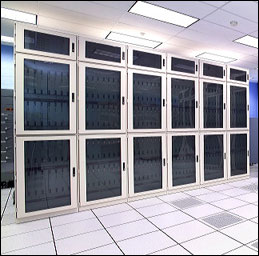National Laboratories Offer Computing Time to Japanese Physicists in Wake of Earthquake
May 23, 2011
The following news release is being issued jointly by the U.S. Department of Energy’s Brookhaven National Laboratory, Fermi National Accelerator Laboratory, and Thomas Jefferson National Accelerator Facility. Additional media contacts: Katie Yurkewicz, Fermilab Office of Communication, 630-840-4112, katie@fnal.gov, and Dean Golembeski, Jefferson Lab Public Affairs, 757-269-7689, deang@jlab.org.

The US QCDOC supercomputer located at Brookhaven Lab
May 23, 2011 — Computational power from facilities at three U.S. Department of Energy national laboratories is aiding Japanese physicists in their quest to understand the interactions that lie at the heart of matter. From now until the end of 2011, while computing facilities in eastern Japan face continuing electricity shortages, a percentage of the computing power at Brookhaven National Laboratory on Long Island, Fermi National Accelerator Laboratory near Chicago and Thomas Jefferson National Accelerator Facility in Virginia will be made available to the Japanese Lattice Quantum Chromodynamics (QCD) community.
Lattice QCD is a computational technique used to study the interactions of quarks and gluons, the basic building blocks of 99 percent of visible matter. Such calculations require enormous computing power, and as a result groups of QCD physicists worldwide have built dedicated high-performance computing facilities designed specifically for Lattice QCD calculations. In eastern Japan following the devastating earthquake in March 2011, such facilities are turned off during periods of high electricity usage to ensure that power is available for essential activities.
“We appreciate the support from the U.S. QCD community,” said University of Tsukuba Vice President Akira Ukawa, spokesperson of the Japanese Lattice QCD community. “The sharing of resources will not only be instrumental to continue research in Japan through the current crisis, but will also mark a significant step in strengthening the international collaboration for progress in our field."
To help their Japanese collaborators continue their research and ensure the progress of this international scientific endeavor, physicists from the USQCD collaboration have offered to share their computational resources located at Brookhaven Lab, Fermilab and Jefferson Lab with their colleagues in Japan.
“We’re very happy that the shared use of our resources can allow our Japanese colleagues to continue their research during a time of crisis,” said Fermilab theoretical physicist Paul Mackenzie, spokesperson for the USQCD collaboration.
Brookhaven Lab is also offering up to one-sixth of the computing time, or about two teraflops of processing power, on a Quantum Chromodynamics on a Chip, or QCDOC, supercomputer designed and built in collaboration with Columbia University and the Japanese institute RIKEN. A smaller fraction of processing time on New York Blue, Brookhaven’s IBM Blue Gene supercomputer, will also be available to Japanese physicists.
Lattice QCD computing facilities at Brookhaven Lab, Fermilab and Jefferson Lab have been developed and are operated by projects jointly funded by the Department of Energy’s Offices of High Energy Physics and Nuclear Physics. The use by Japanese researchers of existing U.S. resources will strengthen the overall world effort in Lattice QCD, while allowing the U.S. projects to continue to meet their performance goals. Lattice QCD computations are essential for interpreting many experiments and observations made around the world in the fields of particle physics, nuclear physics and astrophysics.
Brookhaven National Laboratory is operated and managed for DOE’s Office of Science by Brookhaven Science Associates, a company founded by the Research Foundation of the State University of New York, for and on behalf of Stony Brook University, the largest academic user of Laboratory facilities; and Battelle Memorial Institute, a nonprofit, applied science and technology organization.
Fermilab is a Department of Energy national laboratory operated under contract by the Fermi Research Alliance, LLC. Visit Fermilab on the Web at www.fnal.gov, or follow Fermilab on Twitter at @FermilabToday.
Jefferson Lab is managed and operated for the U.S. Department of Energy's Office of Science by Jefferson Science Associates, LLC, a joint venture between Southeastern Universities Research Association, Inc. and CSC Applied Technology Group, LLC.
2011-11283 | INT/EXT | Newsroom









